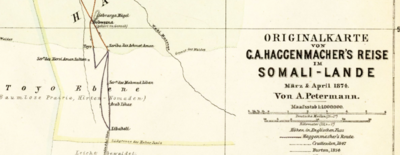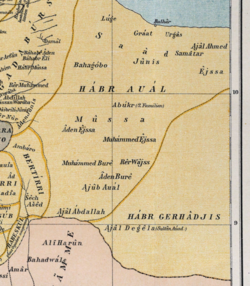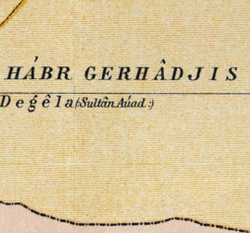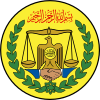سلطنة الحبر يونس
سلطنة الحبر يونس Saldanadda Habar Yoonis | |||||||||
|---|---|---|---|---|---|---|---|---|---|
| ~1769–1907 | |||||||||
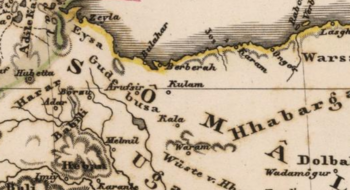 ورام، أول عاصمة لسلطنة الحبر يونس. | |||||||||
| العاصمة | وضان (الأولى) تويو (الثانية) بورعو (الأخيرة) | ||||||||
| اللغات المشتركة | الصومالية • العربية | ||||||||
| الدين | الإسلام السني | ||||||||
| الحكومة | ملكية | ||||||||
| سلطان | |||||||||
• 1769–1797 | سوغوله بن عيَناشي | ||||||||
• 1879–1907 (الأخير) | نور أحمد أمان | ||||||||
| التاريخ | |||||||||
• تأسست | ~1769 | ||||||||
• انحلت | 1907 | ||||||||
| |||||||||
| اليوم جزء من | إثيوپيا أرض الصومال | ||||||||
سلطنة الحبر يونس (صومالية: Saldanadda Habar Yoonis، إنگليزية: Habr Yunis Sultanate)، هي ملكة صومالية كانت تحكم القرن الأفريقي في القرن الثامن عشر. كانت تمتد على أراضي قبيلة الحبر يونس التي تمثل اليوم جزء من أراضي قبيلة إسحاق في أرض الصومال وإثيوپيا المعاصرتين. كانت السلطنة تحت حكم رير بن عيَناشي، أحد أفخاذ قبيلة الحبر يونس.[1][2][3][4]
التاريخ
التأسيس
ترجع جذور سلطنة الحبر يونس إلى سلطنة إسحاق التي أسسها رير گولد، أحد أفخاذ قبيلة غرحجس بعد أن هزمت قبيلة أبسم سلطنة إسحاق في الفروج في القرن السابع عشر. بمرور الوقت انفصلت قبيلة الحبر يونس ثم الحبر أول والحبر جعلو عن سلطنة إسحاق مع تشكيل الحبر يونس سلطنة خاصة بهم بقيادة سوغوله ابن زعيم قبيلة الحبر يونس السابق، عيَناشي حرسي.[5][6] أسس السلطان دريا بن عيَناشي عاصمته في وضان (ورام) بالقرب من ممر الشيخ وفرض الضرائب وأدار شؤون السلطنة من عاصمته. كانت القوافل الكبيرة المتجهة إلى بربرة تمر عبر أراضي الحبر يونس عبر بورعو ثم وضان وأثبتت أنها مصدر دخل مربح للسلطان دريا.[7]
التوسع وحرب الرياد
في أعقاب وفاة السلطان دريا في الخمسينيات، جاء حفيده حرسي أمان ليخلفه ويفتتح حقبة الفتح. ينتمي حرسي أمان إلى فرع باه مكاحل من أسرة سوجول.[8][9] عام 1870 شن حروب الرياد التي استمرت بشكل متقطع من عام 1870 حتى 1940 وأنتجت سلسلة من القصائد، سلسلة جوبا الشعرية، وهي واحدة من أكثر السلاسل شهرة في تاريخ الصومال.
التقى المستكشف السويسري هاگنماشر مع حرسي أمان عام 1873 وكتب أيضًا عن معركة الحبر يونس الناجحة التي حدثت أثناء زيارته.
كان لدى الحبر يونس العديد من الجرحى، لكنه كانو غنياً أيضاً عن طريق النهب، وكان عدد الثروات المنهوبة لا يقل عن 10000 جمل.[10]
في معركة حارو دييج ("بحيرة الدم") في الحوض، أسرت سلطنة الحبر يونس المنتصرة سلطان نهر الرير هارون أوجادين وسقط العديد من الضحايا على الجانبين. أرسل السلطان المأسور رسالة إلى حرسي يقول فيها إنه يجب تجنبه. وردًا على ذلك رد حرسي بعبارة "لابا جوب كي بير جيليسان با جابا" بمعنى "يموت رقيق القلب بين نظيرين" وتم إعدام السلطان الأسير بعد ذلك.[11]
الحرب الأهلية الأولى
على الرغم من النجاحات العظيمة التي حققها حرسي أمام واستحواذه على أراضي جديدة ، إلا أن الفروع الأخرى من قبيلة رير سوغوله أصبحت حذرة من قوته المتزايدة كحاكم وهبت لإيقافه، خوفًا من قيادته غير المنضبطة. كان للحكيم جوليد حاجي، وهو عضو بارز آخر وكبير من شيوخ الدير سوغوله، تداعيات مع السلطان حرسي، وقتل ابنه على يد أحد أبناء حرسي. اقترب نجل حرسي من والده وناشده أن يدفع الدية لجوليد عن فقدان ابنه. رفض حرسي بغطرسة واندلع صراع شامل بين با أول (أحد فروع قبيلة حرسي) وباهو سوجولي التابعة لرير سوغوله.[12]
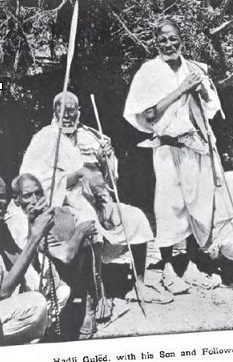
قُتل السلطان حرسي نفسه في معركة بعد بعض الاشتباكات المبكرة وسقط قائده وارسام لاحقًا. قامت شقيقة وارسام، حزنًا على فقدان حرسي وزوجها وأبنائها وأقارب آخرين، بكتابة هذه القصيدة التي سجلها كل من فليپ پوليتشكي وروبتشي بريتشيتي.[13]
بعد وفاة حرصي، اجتمع رير سوغوله وكانت قضية التعويض عن وفاة السلطان قضية ملحة. بدأ النزاع في الأصل لأنه لم يتم دفع دية إلى جوليد حاجي عن مقتل ابنه. قرروا عدم دفع أي تعويضات وحاولوا لاحقاً وضع حد لهذا الصراع.[14]
فترة السلاطين المزدوجين

بعد وفاة السلطان حرسي أمان تنافس فرعان على حكم السلطنة، بهاء دريا وبهاء مكاحل من أسرة سوغوله، مما أدى لانقسام قبيلة الحبر يونس إلى فصيلين، فصيل بهاء دريا بقيادة الحبر جوليد حاجي توج عوض دريا، ابن السلطان دريا سوغوله. أما فصيل بهاء مكاحل فقد توج نور أحمد أمان، الملا الشاب وابن أخ حرسي أمان. كان نور في البداية غير مستريح وفضل حياته كملا بدلاً من أن يكون سلطاناً. لم تنتهي سلطنة الحبر يونس بقيام أرض الصومال البريطاني التي تأسست عام 1884 وما زالت إلى حد كبير منحدرة نحو الساحل وعاصمتها بربرة.[15][16] انخرط السلطانان في حرب طويلة وقسموا أراضي السلطنة، حيث حكم عوض السلطنة من عاصمته المختارة بورعو وحكم نور من سهول تويو وأودوينه.[17]
عام 1884 زار فرانك ليسلي جيمس السلطان عوض في بورعو وشهد الموقف التنافسي بين السلطانين. وصف الوضع السياسي في المنطقة والغارات المتكررة بين فصيلي رير سوغوله المتناحرين وعشائر الحبر يونس المتحالفة معهم.
يبدو أن قبيلة الحبر جرجس العظيمة منقسمة إلى فصيلين متنافسين، أحدهما يتمسك بالولاء للسلطان عوض، والآخر يبايع ابن عمه السلطان نور. بين هذين البلدين كانت البلاد مقسمة بالتساوي، وكان خط الحدود مشهدًا دائمًا للحروب وشائعات الحروب والغارات على الماشية ومحاولات القتل.[18]
كانت قبيلة الحبر-غرحجس في السابق تحت حكم سلطان واحد وكانت قوية للغاية، حيث قامت بغارات متكررة على مدار عقدين، لكن بعد وفاته، قام اثنان من أبناء عمومته، عوض ونور، بتقسيم البلاد بينهما.[19]
لقى عوض مصرعه أثناء القتال في أوجادين على يد رير علي.[20][21] سمح ذلك للنور بتأسيس نفسه في بورعو والسيطرة على سلطنة الحبر يونس بالكامل. لم يعترف فصيل بهاء ديريا بالهزيمة وقاموا في النهاية باختيار ابن شقيق عوض، مدار حرسي، خلفاً لنور بعد وفاته.[22] عقد السلطان نور "شيرًا" للحبر يونس وقرر إجراء القرعة لتسوية الخلاف مع منافسه مدار حرسي بدلاً من الاستمرار في الاقتتال الداخلي الأحمق الذي استمر منذ وفاة حرسي أمان. فاز السلطان نور ومنح مدار حرسي 100 جمل كتعويض وأعلن سلطاناً للحبر يونس بلا منازع.[23] استمر الحكم الموحد تحت حكم السلطان نور حتى تشكلت حركة الدراويش بعد عدة سنوات عام 1899.
فترة الدراويش المبكرة
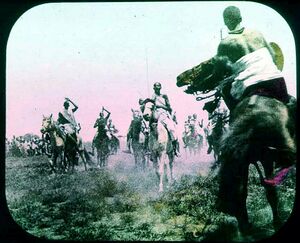
Sultan Nur had been the architect of disturbances at Berbera and was the man who narrated the famous story of French Catholic missionaries in Berbera converting Somali children.[24][25] According to the consul-general James Hayes Sadler this news was either spread or concocted by Sultan Nur of the Habr Yunis. Madar Hersi his former rival for the Sultan title had aided the Mullahs of Kob Fardod in recovering livestock that was previously looted by some of the Habr Yunis and this reignited after receiving aid from the Mullahs there notably Mohammed Abdullah Hassan.[26][27] Upon his visit to Oodweyne in July 1899 Sultan Nur convened a great shir of the western Habr Yunis clans and called on them to join the new Dervish movement and upon their refusal he would leave to Burao and successfully rallied the eastern sections of the clan. The Dervish would declare war from Burao on September 1 of 1899.[28] Madar was soon propagated as the legitimate Sultan by British authorities and managed the western sections of the clan throughout the period of the Dervish wars.
الاندماج مع أرض الصومال البريطاني
Sultan Nur continued and would be heavily involved as a key figure of the Dervish movement and the main signatory of the Treaty of Illig in 1905 that granted them large tracts of today's Nugaal and the port of Eyl from the Italians to use.[29] Following Sultan Nur's death in 1907 he was entombmed in Taleh the headquarters of the movement and his son Dolal Nur was crowned by the Dervish Habr Yunis clans while Sultan Madar Hersi the more established and powerful of the two eventually would become the uncontested Sultan as Dolal died prematurely in 1917 and left no heirs.[30] With the widespread involvement of the British in the interior against the Dervish the once defacto independent interior clans were brought under British administration and the Habr Yunis Sultanate would end.
الاقتصاد
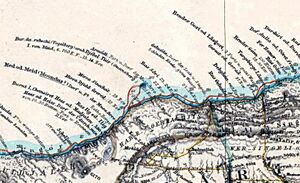
The Habr Yunis Sultanate had strong economy and controlled two routes to the major port of Berbera leading from the Jerato and Sheikh mountain passes into the Hawd and Ogaden country. The key city of Burao was the Trade was significant and bolstered during the period that a Habr Yunis man Sharmarke Ali Saleh had established himself as Emir of Berbera and Zeila.[31][32] The eastern sections of the Habr Yunis had coastal access and several ports of their own. They attained a lot of frankincense in the mountains south of Maydh and Harshaw. Arab and Banyan merchants would visit Maydh for commerce before continuing on to the larger ports such as Berbera and Zeila.[33] Maydh was the preeminent export point for large hides the town had dialogue with Berbera with a large amount of cross trade occurring usually by dhow.[34] As well alongside other northern Somalis and Isaaqs in particular, the Habr Yunis were significant traders in Yemen with Frederick Hunter giving an 1877 account of their trade.[35]
Somalis of the Habr Gerhajis tribe arrive from Ogadain with feathers, myrrh, gum, sheep, cattle, and ghee, carrying away in exchange piece goods; they also make four trips in the season; they remain for less than a month, and during their stay reside with fellow-tribesmen, taking their meals in the mokhbâzah or eating-house.
الإدارة
Sultans of the Habr Yunis exercised power both indirectly and directly through allied Akils and leaders of the various subclans of the wider clan and by leading the Habr Yunis in battle against rivals. The seat of Habr Yunis Sultans was deliberately chosen in Wadhan and later Burao along the caravan route in order to have a firm grip on trade and also ensure a steady stream of taxes from passing traders.[36] New information would be passed along these trade routes and the Sultans would be well informed of occurrences as the Somalis have a penchant for being informed about things. Explorer Ricahrd Burton in his 1854 journey to Harar heard from local Somalis who told him the latest reports from the ongoing Crimean War.[37] The capitals of Wadhan and Burao served as important watering places for both merchants and nomads alike and access to them was crucial for orderly trade from the Hawd and Ogaden regions to Berbera.[38] According to the current Sultan Osman Ali, the oldest son of a Sultan is the rightful heir, but if he does not fill the requirements another son can be selected. A Sultan has to be religious, an eloquent speaker, courageous, and has to be fertile. A guurti of 40 leading elders from the Habr Yunis subclans would come to make this decision on the successor.[39] Sultans would receive a yearly tribute or saado of livestock imposed on the rest of the Habr Yunis.[40][41] Sultan Osman Ali states that the Sultan distributed the livestock amongst the Habr Yunis to the less fortunate and needy as a form of welfare.[42]
الحكام
The Habr Yunis Sultanate had eight rulers throughout its duration and the institution of Sultan still lasts today with the Baha Deria leading I conflict still not being completely resolved. The Bah Makahil maintain a well respected pretender although the current Sultan Osman Ali Madar of the Baha Deria is considered as the Sultan of the Habr Yunis.[43]
|
الاسم |
حكم من | حكم إلى | |
|---|---|---|---|
| 1 | Ainasha Hersi (traditional chief) | ||
| 2 | Sultan Sugulleh Ainasha (first sultan) | ||
| 3 | Sultan Diriyeh Sultan Sugulleh Ainasha | ||
| 4 | Sultan Hersi Aman Sultan Diriyeh | ||
| 5 | Sultan Nur Ahmed Aman Sultan Diriyeh | ||
| 6 | Sultan Awad Sultan Diiriye | ||
| 7 | Sultan Dolal Sultan Nur | ||
| 8 | Sultan Madar Hersi Sultan Diiriye |
الذكرى
Amongst the Habr Yunis the traditional institution and leadership of the clan survived the British Somaliland period into present times. The Rer Ainashe Sultans although no longer ruling vast territory and with separate Habr Yunis subclans having their own Sultans still remain status the recognized leaders of the Habr Yunis. The current Sultan is Osman Ali Madar who is active in social issues in modern day Somaliland.[44]
المصادر
- ^ d'Abbadie, Antoine (1890). Géographie de l'Ethiopie: ce que j'ai entendu, faisant suite à ce que j'ai vu. Mesnil. p. 334. ISBN 9781173215750.
- ^ Cosmos: communicazioni sui progressi recenti e notevoli della geografia e delle scienze affini di Guido Cora, p.201
- ^ British Somaliland By Drake Brockman. 1912.
- ^ Truhart, P. (1984). Regents of nations: systematic chronology of states and their political representatives in past and present : a biographical reference book. pp.72
- ^ YouTube, a Google company. YouTube.
{{cite AV media}}: CS1 maint: url-status (link) - ^ NEW ISSUES IN REFUGEE RESEARCH Working Paper No. 65 Pastoral society and transnational refugees: population movements in Somaliland and eastern Ethiopia 1988 - 2000 Guido Ambroso, Table 1, pg.5
- ^ The Transactions of the Bombay Geographical Society 1850, Volume 9, p.133
- ^ British Somaliland, by Ralph E. Drake-Brockman
- ^ Andrzejewski, B.W. and I.M. Lewis, 1964, Somali Poetry: An Introduction, Oxford University Press, Oxford, p.106
- ^ G. A. Haggenmacher's Reise Im Somali-Lande, 1874: Mit Einer Originalkarte by G.A.
- ^ The Unknown Horn of Africa, Frank Linsly James, pg.335
- ^ War and Peace: An Anthology of Somali literature, p.169
- ^ Rendiconti by Reale Accademia dei Lincei; Reale Osservatorio del Campidoglio published 1885. Page 228.
- ^ War and Peace: An Anthology of Somali literature, p.169
- ^ British Somaliland by Drake Brockman, pp.79 - 82
- ^ 1912 Proceedings of the Royal Geographical Society and Monthly Record of Geography 1885, Volume 7, p.627
- ^ The Academy: a weekly review of literature, science, and art. Volume 35, 1889, p.126
- ^ The Unknown Horn of Africa: An Exploration From Berbera to the Leopard River, 1888
- ^ Proceedings of the Royal Geographical Society and Monthly Record of Geography, 1885, Volume 7, p.627
- ^ British Somaliland. Drake Bromen. 1912.
- ^ Notes on Somali history. Leicestershire Regment: By Captain G.D Carelton.
- ^ Journal of the Anthropological Institute of Great Britain and Ireland, Vol. 21, p.161
- ^ British Somaliland by Drake Brockman, pages 79–82, 1912.
- ^ Under the flag: and Somali coast stories by Walsh, Langton Prendergast. p. 243
- ^ Somali Coast administration Report of the protectorate 1892–1893, Bombay Castle, NAY, New Delhi
- ^ Churchill and the Mad Mullah of Somaliland: Betrayal and Redemption 1899-1921. p. 24 by Roy Irons
- ^ Correspondence respecting the Rising of Mullah Muhammed Abdullah in Somaliland, and consequent military operations, 1899-1901. P. 4.
- ^ Correspondence respecting the Rising of Mullah Muhammed Abdullah in Somaliland, and consequent military operations, 1899-1901. P. 8.
- ^ Il Benadir, Vico Mantegazza. 1908. pp. 323–324
- ^ British Somaliland by Drake Brockman, pages 82, 1912.
- ^ d'Abbadie, Antoine (1890). Géographie de l'Ethiopie: ce que j'ai entendu, faisant suite à ce que j'ai vu. Mesnil. p. 334. ISBN 9781173215750.
- ^ Pankhurst, R. (1965). Journal of Ethiopian Studies Vol. 3, No. 1 (in الإنجليزية). Institute of Ethiopian Studies. p. 45.
- ^ Pankhurst, Richard (1965). "The Trade of the Gulf of Aden Ports of Africa in the Early Nineteenth and Early Twentieth Centuries". Journal of Ethiopian Studies. 3 (1): 36–81. JSTOR 41965718.
- ^ Great Britain, House of Commons (1905). Sessional papers Inventory control record 1, Volume 92. HM Stationery Office. p. 391.
- ^ Hunter, Frederick (1877). An Account of the British Settlement of Aden in Arabia. Cengage Gale. p. 41.
- ^ d'Abbadie, Antoine (1890). Géographie de l'Ethiopie: ce que j'ai entendu, faisant suite à ce que j'ai vu. Mesnil. p. 334. ISBN 9781173215750.
- ^ First Footsteps in East Africa: Or, An Explanation of Harar. Richard Francis Burton, pg 188
- ^ A Pastoral Democracy: A Study of Pastoralism and Politics Among the Northern Somali of the Horn of Africa, pg.187
- ^ Suldaan Cismaan Cali Madar Interview, SAAB TV, 18/05/2017. https://www.youtube.com/watch?v=9xxXHkd_6nM&feature=youtu.be
- ^ The Journal of The anthropological institute of Great Britain and Ireland| Vol.21 p. 161
- ^ Journal of the East Africa Natural History Society: Official Publication of the Coryndon Memorial Museum Vol.17 p. 76
- ^ Suldaan Cismaan Cali Madar Interview, SAAB TV, 18/05/2017. https://www.youtube.com/watch?v=9xxXHkd_6nM&feature=youtu.be
- ^ "Suldaan Cismaan Suldaan Cali Madar Oo Farriimo Culus U Diray Maamulka Muuse Biixi Iyo Maamulka Farmaajo". Sayruuq News (in الإنجليزية الأمريكية). 2018-01-09. Retrieved 2021-02-15.
- ^ "Suldaan Cismaan Suldaan Cali Madar Oo Farriimo Culus U Diray Maamulka Muuse Biixi Iyo Maamulka Farmaajo". Sayruuq News (in الإنجليزية الأمريكية). 2018-01-09. Retrieved 2021-02-15.
- CS1 maint: url-status
- CS1 الإنجليزية الأمريكية-language sources (en-us)
- Short description is different from Wikidata
- Articles containing صومالية-language text
- Pages using Lang-xx templates
- Articles containing إنگليزية-language text
- Articles with hatnote templates targeting a nonexistent page
- سلطنات
- القرن 17 في إثيوپيا
- القرن 18 في إثيوپيا
- القرن 19 في إثيوپيا
- الإسلام السني في أفريقيا
- ملكيات مسلمة
- تاريخ أرض الصومال
- امبراطوريات صومالية
- التاريخ الحديث المبكر لأرض الصومال
- سلطنة إسحاق
- بلدان سابقة
